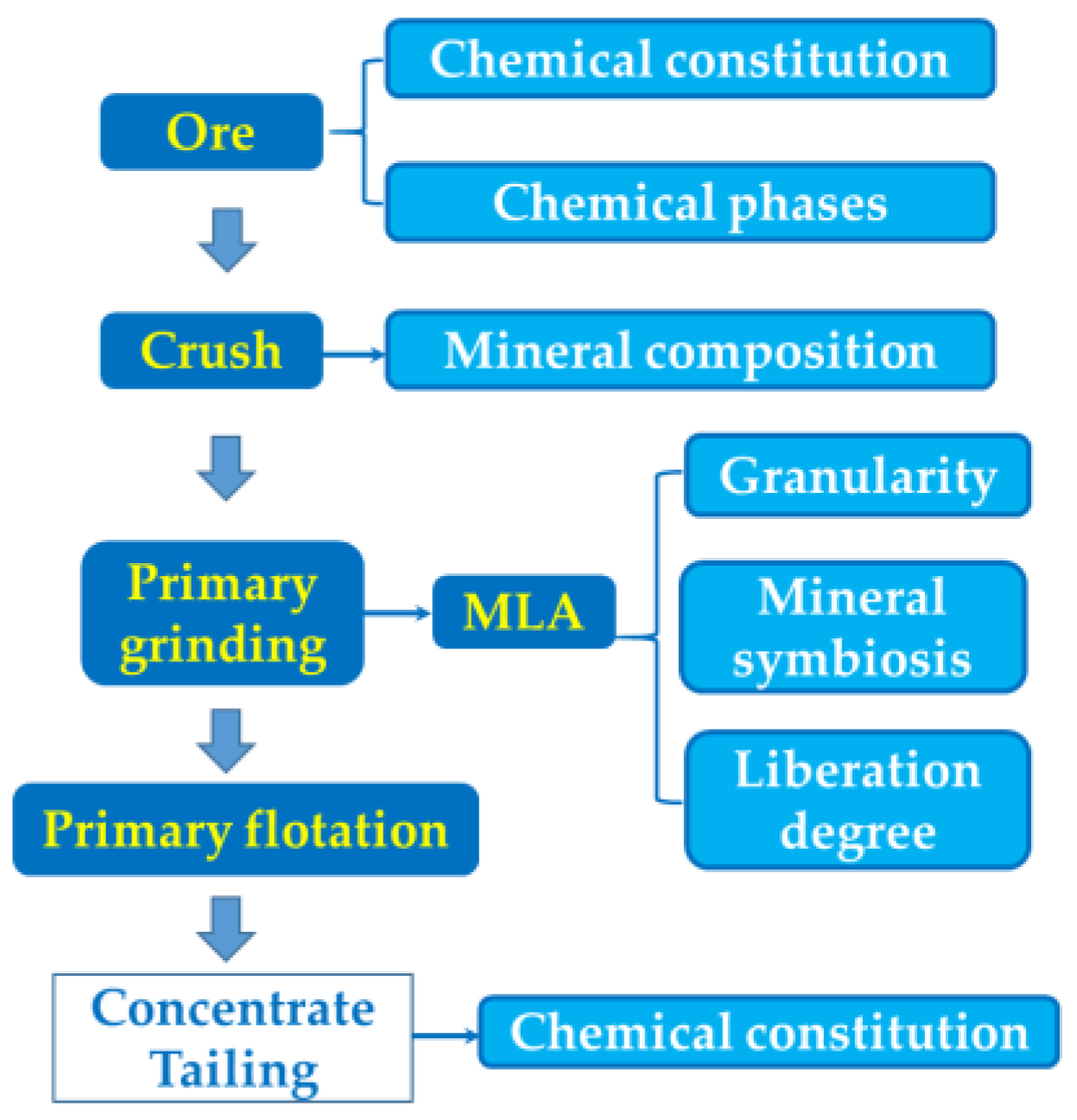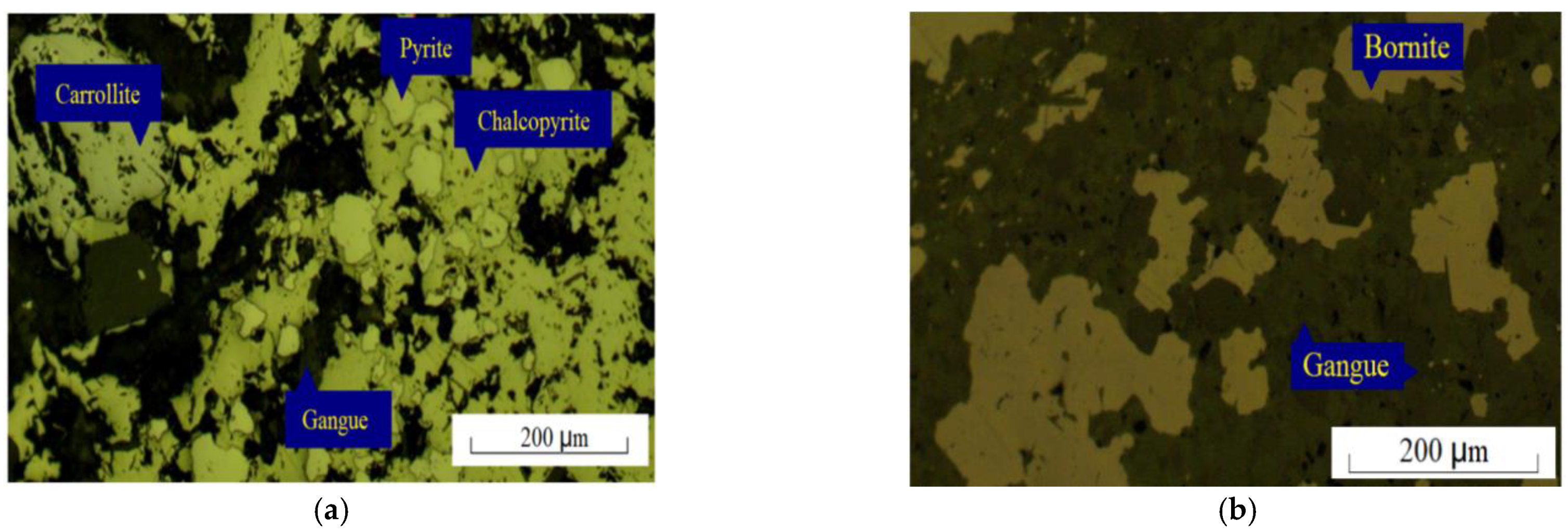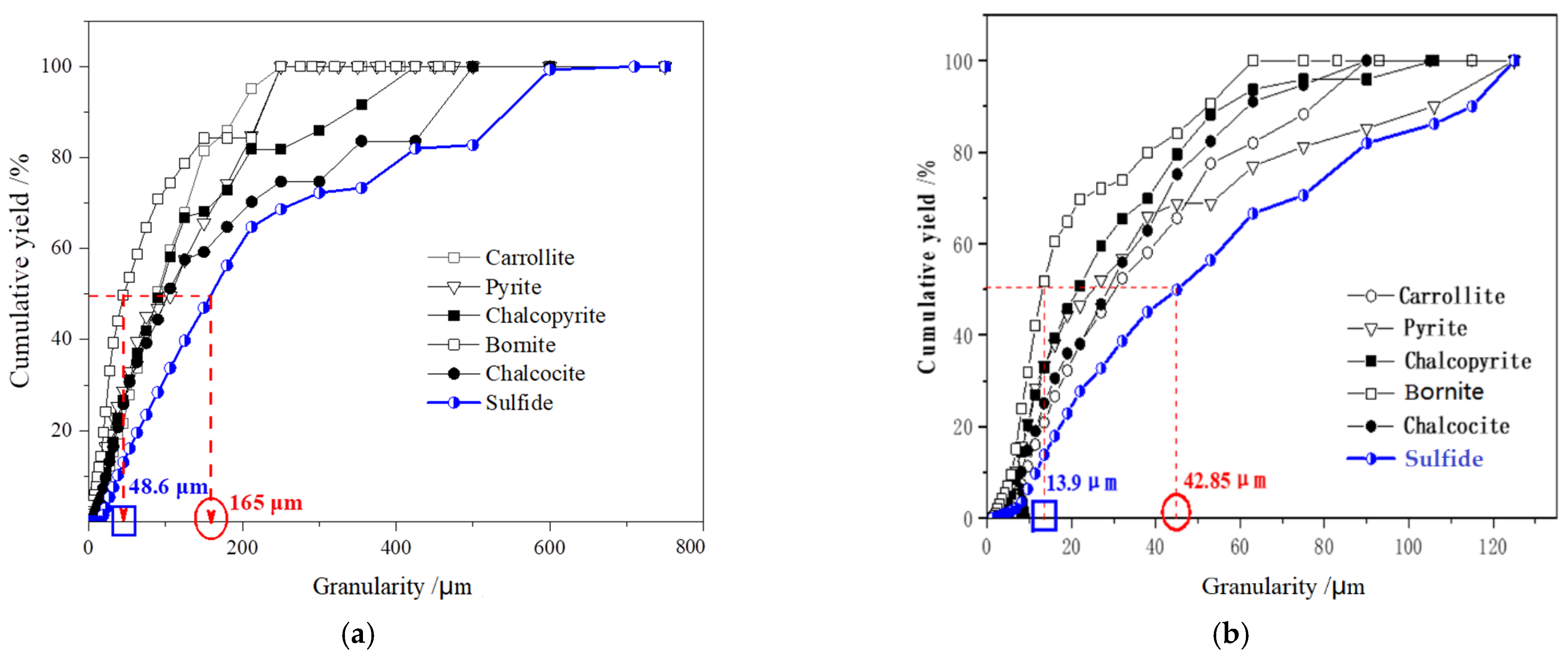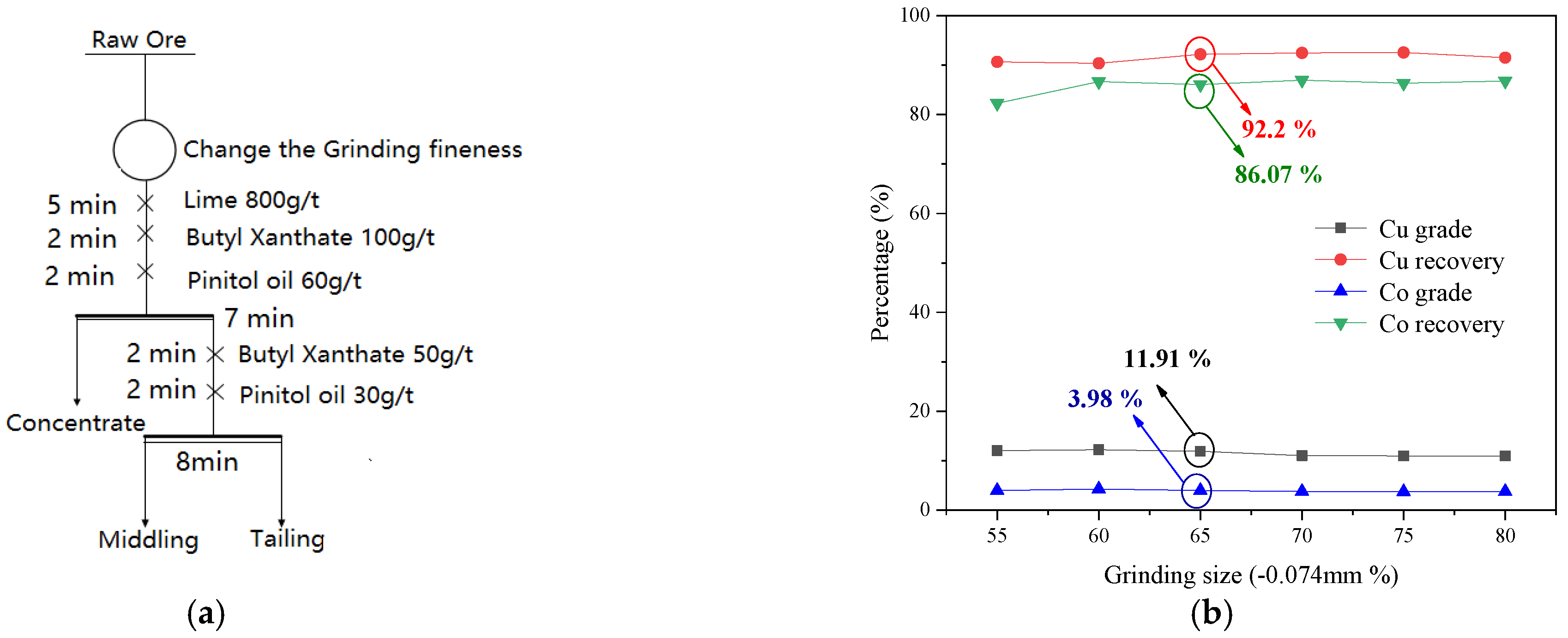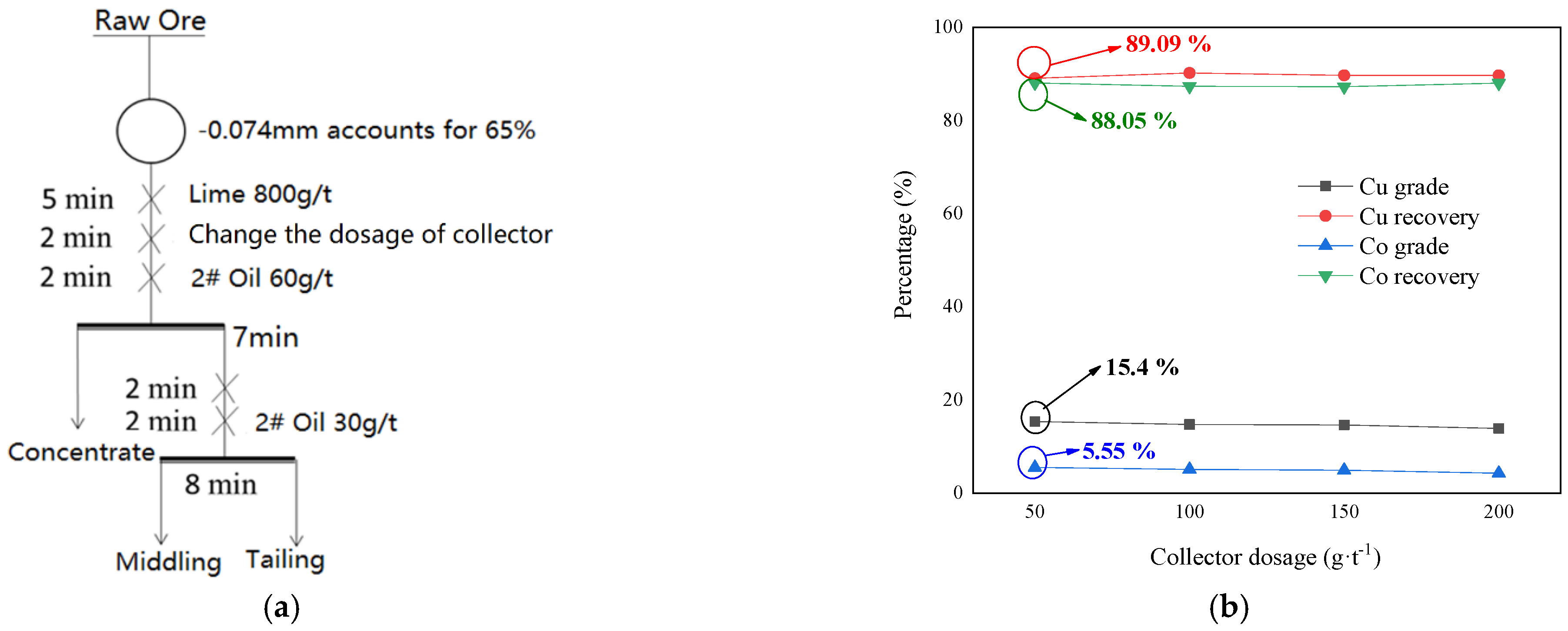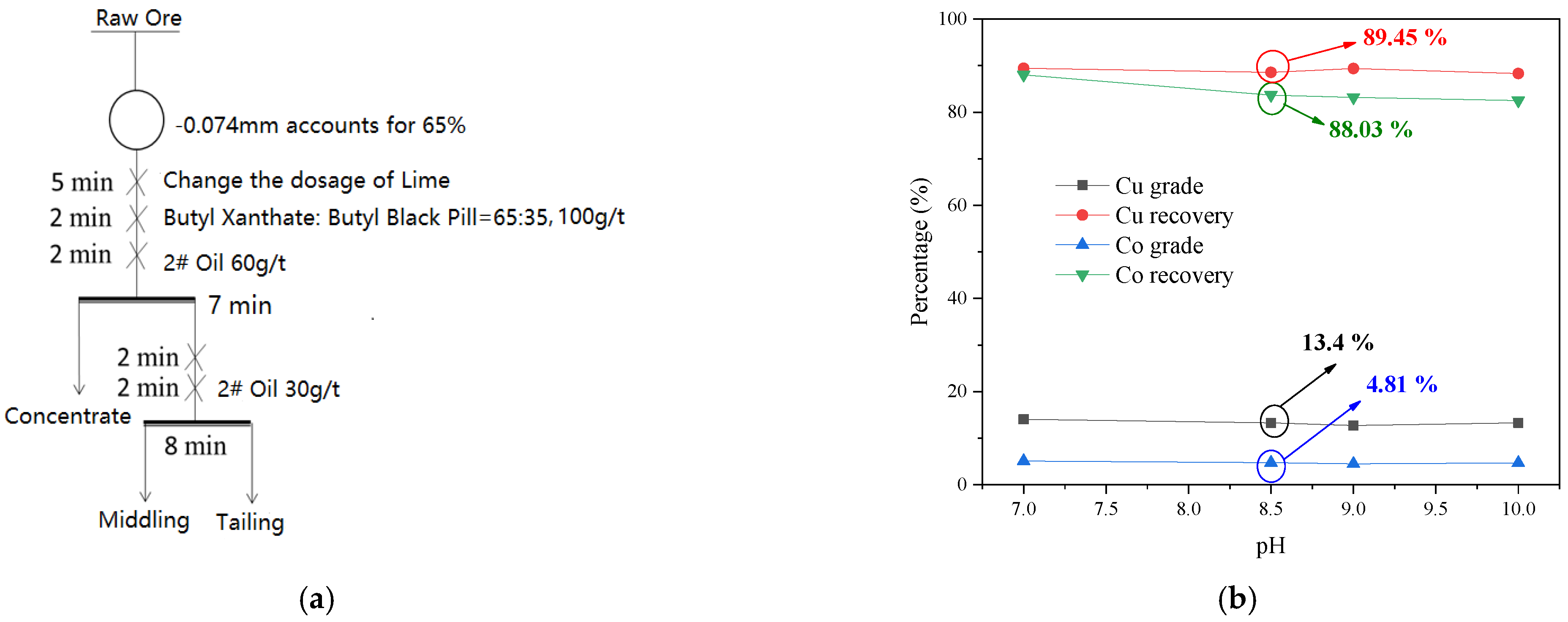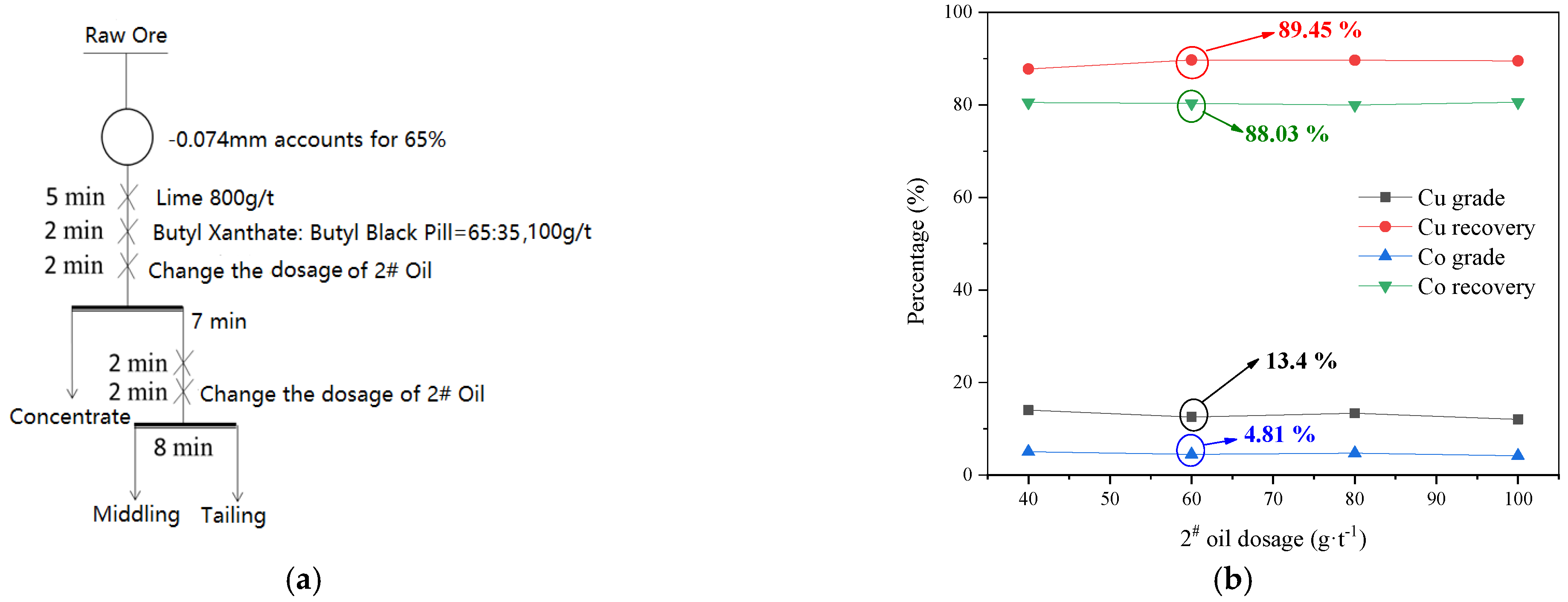1. Introduction
Cobalt is known for its excellent performance, and thus widely employed in machinery, electronics, electric power, automobile, construction, and many other industries. The global consumption of cobalt is expected to undergo a three-fold increase in the next 10 years [
1,
2,
3]. According to the United States Geological Survey (2017), most of the world’s tradable cobalt reserves were found in the sediment-hosted Cu–Co deposits in the Democratic Republic of Congo (DRC), where cobalt sulfides were recovered as a by-product of copper minerals [
4,
5,
6]. Copper is also a widely employed metallic element [
7]. Hence, the improvement of cobalt recovery depends on the synchronous recovery of copper–cobalt sulfides [
8]. The mineral composition of copper–cobalt ores is more complex than that of copper sulfides, and it falls under the difficult beneficiation type [
9]. Therefore, beneficiation researchers from all over the world have made numerous attempts to concentrate copper–cobalt sulfide ores. At present, the separation methods used for copper–cobalt sulfide ores include the following: Duan et al. [
10] improved the recovery rate of copper–sulfur minerals by changing the reagent system. Ba et al. [
11] adjusted the process flow and used combined flotation–magnetic separation technology to recover cobalt minerals, which are difficult to enrich. However, the large-scale use of reagents exerts high environmental impact, and ideal process indicators are difficult to obtain even with complex processes. Tijsseling et al. [
2] adopted a two-stage roughing process: the first step is the separation of sulfide in the ore for use as potential sulfidation material for the sulfidization of the remaining oxides, and the second step is recovery. However, the flotation concentrate tends to contain a large amount of carbonate and silicate minerals. Moreover, the selectivity of the flotation process tends to be low because of the absence of a clear guideline on the choice of particle size for middling. Some low-efficiency methods, such as biological leaching and ammonium salt roasting, could hardly separate copper and cobalt sulfide ores [
12,
13,
14,
15]. In sum, concentrating copper cobalt sulfide ores remains challenging, and many mechanisms of separation have yet to be revealed. Information such as the composition, embedded characteristics, crystal size, and crystal structure of minerals from the microscopic view is obviously needed to reveal the common characteristics that support comprehensive concentrating in primary flotation. Meanwhile, new theories are also necessary to organize test results and break through the technological limitations of concentrating copper and cobalt minerals.
The minerals, ores, mineralogical characteristics, and types of ore deposits share internal relations. The characteristics of ores develop during ore deposit generation. Deposits with the same type share the same characteristics, which affect the progress of grinding, gravity separation, magnetic separation, and flotation. Current research has achieved remarkable progress in this field. For example, Tijsseling et al. [
16] adopted a group of ore samples to test the effect of mineralogical characteristics on their flotation performance by using an automated mineralogy and petrography analyzer; then, they established a quantitative equation between the two groups of parameters. Wu et al. [
17] continuously optimized the process flow of copper sulfide ore dressing and investigated process mineralogy to realize the innovative development of research methods and production transformation. Sun et al. [
18] studied the mineralogical characteristics and mineral dissemination size of magnetite concentrates in China. The internal connection between the mineralogical characteristics of ores and the separation index was established in the study. Accordingly, a feasibility evaluation system for the preparation of super iron concentrates based on process mineralogy was established to provide technical support for the efficient preparation of super iron concentrates. Dehaine et al. [
19] indicated most cobalt concentrate in the world is obtained from complex deposit mostly Cu–Co sediment-hosted sulfide type, and produced as a by-product of other sulfide mineral. Tijsseling et al. [
2] studied an oxide-sulphide type cobalt-copper mixed ore. Different species of minerals associated together, whereas the cobalt and cooper elements were hosted in diverse mineral phases, thus the separation of cobalt and copper minerals could be conducted by potential-controlled flotation. Cross et al. [
20] found the total volume of sulfide ore was related to chargeability. Chalcopyrite is the major mineral of responding this regularity among sulfides, while cobalt-bearing sulfides responded little. Here, chalcopyrite particles less than 200 mu m in diameter presented greater respond than that of larger than 200 mu m particles. Whiteman et al. [
21] investigated a copper sulfide ore with the disseminated particle size of 10–27 μm in average from a deposit of Congo. The three best performance grinding products were tested by QEMSCAN, and the connection between the flotation kinetics and liberation degree of the copper sulfide minerals were established. Nisbett et al. [
22] studied the Cu–Co ore in Zambia and Congo (DRC), and found the cobalt minerals typically associating with gangue compactly in the ore and, therefore, consuming excess acid in the leaching process after beneficiation. Wang et al. [
23] conducted a detailed study on the chemical composition, mineral composition, element occurrence state, and intermineral intercalation characteristics of a foreign refractory iron ore and concluded that physical beneficiation methods cannot achieve the effective separation of aluminum and iron. Such ore can only be processed by combining beneficiation and smelting. However, the connection between the mineralogical characteristics of copper cobalt sulfide ores and the roughing process was not fully developed in the literature.
Copper cobalt sulfide ores are difficult to be beneficiated because of their complex structure and the micro-grain dissemination of minerals. The potential process should be designed by adapting ore properties to achieve efficient separation. Micro-grain copper and cobalt minerals coexist closely in the ore with the minerals. Thus, a large amount of energy is needed to grind the ore particles into fine grains to thereby achieve mineral liberation. On the other hand, the flotation regent adopted may not be suited for recovering all species of liberated copper and cobalt sulfide minerals, hence the over-grind operation is harmful to increase total recovery. However, conduct flotation with no-grind coarse grains may lead to unsatisfactory floatability and separation efficiency. Thus, the current investigation introduced mineral liberation analyzer (MLA) [
24,
25] to study the liberation of minerals or mineral aggregates after primary grinding, and thereby chose the proper recovery object and corresponding liberation degree to promote concentrating efficiency and reduce process costs in primary flotation. For instance, the minerals in copper and cobalt ores are finely disseminated, thus the close coexistence of copper and cobalt minerals in ores were utilized to increase the granularity of recovery objects during primary flotation in this work. Here, the MLA was used to analyze the mineralogical characteristics of ores and the particle size of primary flotation tailings, and to evaluate the recovery of sulfide aggregates (involving copper and cobalt minerals). Two technical terms, namely,
ore’s mineralogical characteristics and
fragment’s mineralogical characteristics, are distinguished in this research. The former refers to the
set of technological characteristics of raw ores, whereas the latter describes the residual characteristics of raw ores in the fragments after crushing and grinding. The relationship between the mineralogical characteristics of sulfide mineral aggregates and the effect of tailing discarding was determined, then the process parameters of coarse-grained bulk flotation after primary grinding were optimized. It may provide a new view and method to utilize the connection between ore properties and concentrating technology. The obtained results are supposed to provide some theoretical reference to improve the efficiency of tailing discarding in primary bulk flotation and increase the total recovery of copper cobalt sulfide ores or similar polymetallic sulfide ores.
2. Experimental
2.1. Materials
The analytically pure CaO (lime) employed in this study was purchased from Guoyao Chemical Reagent Co., Ltd. (Shanghai, China), the 2# oil (a terpineol type foaming agent) adopted was purchased from the BGRIMM Technology Group (Beijing, China), and the sulfide ore was obtained from the middle part of Africa.
2.2. Methods
The experimental equipment used included a rod mill (Tankuang, XMB-70, Wuhan, China), three flotation machines (Tankuang XFD12, Wuhan, China; 0.5, 1, and 4 L), a balance (Mettler, AR1140, Switzerland), a filter (Hengcheng, XTLZ, Huaian, China), an ultrasonicator (Ruibo, BRC-20A, Shanghai, China), and a drying oven (Shuangxu, PH050, Shanghai, China). The chemical composition of the samples was analyzed by an atomic absorption spectrophotometer (Rayleigh, UV-9600, Beijing, China). The mineral composition of the ore and the dynamic X-ray diffraction (XRD) images obtained in the reaction process were examined using an MLA (FEI, FEI MLA 250, Hillsborough, OR, USA) and an X-ray diffractometer (Rigaku, TTRIII, Tokyo, Japan), respectively. The process morphology of the ore was determined by a reflection macroscope (Leica, DM4500P, Wetzlar, Germany).
2.2.1. Mineral Composition
The ore was crushed to a granularity of −2 mm (100%), processed into a polished plate, and then tested using the MLA. The MLA combines an automated scanning electron microscope with a large sample chamber, multiple energy dispersive X-ray detectors, and automated quantitative mineralogy software. It can control the scanning electron microscope hardware and comparison databases for the quantitative phase analysis of mineral and material samples. It can also perform electron backscatter diffraction imaging and X-ray analysis on at least 5000 particles in a sample and test the mineral composition of a particle as small as 0.2 μm. Moreover, it can provide testing solutions for all types of complex and ultra-fine nonferrous metal minerals. Lists and graphical reports can be generated by the DataView software equipped on the MLA after the analysis of samples. The following data can be obtained with the MLA: mineral abundance (modal analysis) and sample element distribution (analysis), particle size distribution, mineral combination, dissociation and interspersed relationship, theoretical grade–recovery rate line, particle density, shape factor, etc.
2.2.2. Mineral Liberation
The grinding of the sample was performed by using a rod mill at the pulp density of 30%. Liberation degree was also tested with the MLA, and the degree was determined by the area percentage of a certain mineral in a particle. The densities of minerals were also considered. If the liberation degree is more than 90%, then the mineral is regarded as completely liberated; if the degree is less than 10%, then the mineral is considered as unliberated. Thus, the liberation degrees of the minerals in the current investigation ranged from 10% to 90%.
2.2.3. Grade and Recovery of Concentrate
The grade of element was directly tested by an atomic absorption spectrophotometer, and the recovery of Cu or Co during the separation was calculated using Equation (1):
ε, the recovery of element during separation, %;
α, the grade of element in the ore, %;
β, the grade of element in the concentrate, %;
γ, the mass recovery of concentrate during separation, %.
2.2.4. Grinding and Flotation Experiments
The ore was crushed into a particle size of −2 mm, dried, weighed, and then primarily ground with a pulp density of 60%. The amount of water for the cleaning rod was controlled to ensure the pulp density was kept at 30%. The ore was fed to the rod mill with a moisture content of <2%, and the filling ratio of the grinding medium was 20%. The flotation conditions optimized in the current research included grinding size, collector type, collector dosage, pH, and 2 oil dosage. The flotation experiments were conducted at room temperature with a pulp density of 30%. The sketch maps of flotation are presented individually in
Section 4 of this manuscript. The feeding ores with a size of −0.074 mm (65%) and −0.074 mm (85.64%) were compared under the same flotation reagent types and dosages to verify the possibility of coarsening the flotation feeding size. The size of the feeding ores for flotation was determined by screening. In each unit flotation, 300 g of ore was adopted to prepare the ore pulp, and the volumes of the flotation cells used were 0.5 L, 1 L, and 2 L.
2.3. Technical Route
The technical route of the current investigation is shown in
Figure 1.
2.4. Checklist of Mineralogical Characteristics
The mineralogical characteristics of ores explored in this work are listed in
Table 1.
The mineralogical characters of ores perform functions directly on minerals concentrating, thus the characters were majorly concerned in the current investigation.
3. Ore’s Mineralogical Characteristics
3.1. Chemical Constitution and Chemical Phase
The chemical constitution and chemical phase data of the ore are presented in
Table 2 and
Table 3, respectively.
The Cu content in the ore was 2.36%, and that of Co was 0.86%. Cu and Co were the main recoverable elements of the sulfide ore. A total of 95.34% of copper minerals existed as sulfides, and that of cobalt was 94.44%. The sulfide minerals were easily floated and recovered. Thus, the ease-flotating of copper and cobalt minerals become the first mineralogical characteristic of ores in this study.
An MLA test was employed to analyze mineral composition. The mineral type and composition of the ore are shown in
Figure 2. Where,
Figure 2a shows the mineral composition of the ore, and
Figure 2b shows the mineral composition of the metallic mineral.
As shown in
Figure 2, gangue minerals, such as quartz, dolomite, and chlorite take up most parts of the ore mass. Thus, discharging most gangue minerals in rougher flotation may avoid further fine grinding and reduce the succeeding grinding power. The metallic minerals account for 6.27% of the total ore mass, with 94.44% of total cobalt existing in carrollite and 94.27% of total copper existing in chalcocite, chalcopyrite, carrollite, and bornite. Only 18.51% of copper and 94.44% of cobalt in the ore occurred in carrollite. The critical effect of carrollite on Cu and Co recoveries was the second mineralogical characteristic of ores in this study. However, cobalt existing in oxide form was encapsulated in limonite as an inclusion. Thus, a certain part of cobalt could not be recovered during the rougher flotation of sulfides. Once cobalt-oxidized minerals dissociate from sulfides in this stage, they may no longer be recovered during rougher flotation.
3.2. Disseminated Granularity of Minerals
The disseminated granularity of a single mineral is fine. Monomer separation is difficult and unnecessary during primary grinding because of its cost. Finding a new basis for determining particle size for sulfide flotation has become inevitable.
The disseminated granularity of major metallic minerals in the ore adopted in this study is shown in
Table 4. The data were obtained by MLA analysis.
The mineral map of the ore is shown in
Figure 3. Sulfides are expressed in mineral form in
Figure 3a and in aggregate form in
Figure 3b.
Most single sulfide minerals in the ore were fine grained (
Figure 3a). However, the minerals coexisted closely and appeared in aggregate form (
Figure 3b); thus, the grains of the aggregates were coarser than those of single sulfide minerals. All sulfide minerals were dyed yellow to demonstrate the change in disseminated granularity from a single mineral to an aggregate (
Figure 3b). The aggregates in the ore easily dissociated from the gangue minerals during the grinding because of their coarse disseminated granularity. The aggregates also presented good floatability in flotation because they were formed by fine-grained and easily floatable sulfide particles. Hence, the concentration of aggregates by flotation becomes possible at a certain grinding size and monomer liberation degree. Moreover, the operation provides an opportunity to reduce grinding cost by discarding coarse tailings in advance. The relative value of the disseminated particle size of sulfide minerals and their aggregates are the third mineralogical characteristic of ores in this study.
3.3. Mineral Symbiosis
Mineral symbiosis was analyzed by the MLA, and the minerals associated with major copper and cobalt minerals are shown in
Table 5.
Bornite, chalcopyrite, and carrollite were associated with gangue; thus, a portion of these minerals tend to be discarded as tailings during primary flotation. Improving the recovery of these minerals increases copper and cobalt recovery. The loss of minerals in tailings, particularly carrollite, which is the major mineral carrier of copper, remarkably and synchronously decreases copper and cobalt recovery.
The chalcocite and limonite are found often embedded together in gangue minerals, i.e., quartz and dolomite. Chalcocite and limonite are commonly embedded in gangue minerals such as quartz and dolomite in ores. The filling structure formed by limonite along the edge of chalcocite or in its fissure represent a close symbiotic relationship between limonite and chalcocite under the conditions of supergene. The gangue minerals in the ore include quartz, dolomite (including cobalt-bearing dolomite), chlorite, potash feldspar, calcite, apatite, fluorite, rutile, malachite, monazite, zircon, etc.
In this study, mineral symbiosis was analyzed using a reflecting microscope, and the images of the major copper and cobalt minerals in the ore are shown in
Figure 4.
As shown in
Figure 4, the major copper minerals in the ore are carrollite, chalcopyrite, and bornite. Most of these sulfide minerals closely coexist and can be easily recovered in aggregate particle form. The remaining minerals are associated with gangue minerals and tend to be lost in tailings during primary flotation. The intergrowth difference of sulfide minerals is the fourth mineralogical characteristic of ores in this study.
5. Primary Flotation
According to the analysis of the mineralogical characteristics of the ore after primary grinding, sulfide aggregates, as recovery objects, offer many advantages, such as the coarsening of primary flotation granularity and increase of the liberation degree of object granularity. Hence, a series of primary flotation experiments were conducted herein to confirm the possibility of recovering sulfide aggregates and reveal the effect of liberation degree on the recovery of sulfide aggregates.
5.1. Effect of Grinding Size
Effect of grinding size on the recovery of sulfide aggregates are shown in
Figure 6; the flotation conditions are shown in the flow chart of the experiments.
The results showed that the rough Cu and Co concentrates were 11.91% and 3.98%, respectively. The grades and recoveries of the Cu and Co elements changed slightly with the increasing grinding size, and the increase of grinding size exerted little effect on Cu and Co recovery when the liberation degree of the sulfide aggregates approached 65%. Moreover, the particles became difficult to recover by flotation when ground to −0.019 mm; thus, the grinding size of −0.074 mm (65%) was selected to avoid overgrinding. At the selected condition, 82.57% of the ore weight discarded as tailing when the recoveries of Cu and Co were 92.2% and 86.07%, respectively.
5.2. Effect of Collector Type
The effect of the collector type on the recovery of sulfide aggregates are shown in
Figure 7.
Aerofloat + xanthate was prepared at a ratio of 35 wt.% aerofloat and 65 wt.% butyl xanthate, and the flotation conditions are shown in the flow chart of the experiment. As shown in
Figure 6, the use of isopentyl xanthate and ammonium dibutyl dithiophosphate as collectors presented better collecting capability than other collectors in terms of concentrate grades. Moreover, the use of ammonium dibutyl dithiophosphate led to satisfactory Cu and Co recoveries. However, the recoveries of copper and cobalt should be prioritized over the grades in such primary flotation aimed to ward discarding tailings. In this work, the corresponding recovery remained unsatisfactory when isoamyl xanthate was employed, although the grades of copper and cobalt were satisfactory. Hence, the collector combination of 35% aerofloat and 65% butyl xanthate was selected as the optimal collector. At the selected condition, 87.23% of the ore weight was discarded as tailing when the recoveries of Cu and Co were 91.91% and 86.1%, respectively.
5.3. Effect of Collector Dosage
The effect of collector dosage on the recovery of sulfide aggregates are shown in
Figure 8. The flotation conditions are shown in the flow chart of the experiments.
The grades and recoveries of Cu and Co changed only slightly as the collector dosage increased from 50 g·t−1 to 200 g·t−1. Given the recovery value of metals, Co was prioritized over Cu as a recovery indicator. Thus, the collector dosage of 50 g·t−1 was selected to reduce cost. At the selected condition, 86.35% of the ore weight was discarded as tailing when the recoveries of Cu and Co were 89.09% and 88.05%, respectively.
5.4. Effect of pH
The effect of pH on the recovery of sulfide aggregates are shown in
Figure 9. The pH values were adjusted by adding CaO. The flotation conditions of the experiment are shown in the flow chart of the experiments.
As shown in
Figure 9, the recovery presented a minimal and uncertain correlation with pH variation. The recovery of copper and cobalt increased linearly with the increase in pH from 8.5 to 9.0. The grade and recovery remained unchanged at pH 9–10. Hence, 9.0 was selected as the optimal pH because the recoveries of copper and cobalt reached their high points at this pH. At the selected condition, 85.07% of the ore weight was discarded as tailing when the recoveries of Cu and Co were 89.45% and 88.03%, respectively.
5.5. Effect of 2# Oil Dosage
Effect of 2# oil dosage on the recovery of sulfide aggregates are shown in
Figure 10. Here, 2# oil is the foaming agent containing terpineol.
The results showed that the grade and recoveries of copper and cobalt reached their peak points under the optimal conditions and at the 2# oil dosage of 60 g·t−1. Therefore, 60 g·t−1 was selected as the optimal 2# oil dosage. At the selected condition, 85.07% of the ore weight was discarded as tailing when the recoveries of Cu and Co were 89.45% and 88.03%, respectively.
